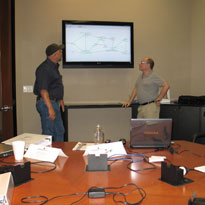TCP/IPv6
- Course:TCP/IPv6
- Course ID:IPV6 Duration:2-3 days Where: Your Office (7+ Persons)
- Download Course Description (PDF)
Available as a private, customized course for your group at your offices or ours and in some cases as a WebLive(TM) class.
Course Outline
- Introduction and TCP/IP Review
- Identify TCP/IP architectural components
- Identify TCP/IP protocols
- Configure IPv4 addresses
- Manual address configuration
- Dynamic address configuration
- Configure subnetting
- Describe the purpose and use of Dynamic Host Configuration Protocol (DHCP)
- TCP/IP Management
- Domain name requirements
- Name servers
- DNS zones
- Routing fundamentals
- Routing protocols
- Management tools
- IPv6 Overview
- Shortcomings of IPv4
- Extending IPv4 address space and usage
- Gradual implementation of IPv6
- Describe IPv6 basic features
- IPv6 supported on Windows
- IPv6 supported on Cisco routers
- Installing IPv6 on a Windows 2003 Server computer
- IPv6 Addressing and Header Structure
- Address prefixes
- Address space allocation
- Types of supported addresses
- Unicast, multicast and anycast addresses
- Identify IPv6 address structures
- Local-link addresses
- IPv6 header format
- Supported next header values
- Purpose and use of next header values
- Extension headers
- ICMPv6 and Management Tools
- ICMPv6 structure
- ICMPv6 messages
- Command line management utilities
- Using network monitor to monitor IPv6 traffic
- Neighbor Discovery and Multicast Listener Discovery
- The neighbor discovery process
- Message structure
- Supported message options
- Multicast listener discovery processes
- Auto-configuration and Name Resolution
- Auto-configuration types
- Comparing stateless and stateful auto-configuration
- IPv6 auto-configuration states
- Host auto-configuration procedures
- Configuring static host addresses
- Domain Name System (DNS) support for IPv6
- IPv6 resource records
- IPv6 Routing
- IPv6 subnetting
- NLA and SLA subnetting
- Router advertisement messages
- IPv6 routing tables
- IPv6 routing protocols
- Windows Server 2003 and Cisco IPv6 functionality
- Configuring router support
- Co-existence
- IPv4 and IPv6 co-existence requirements
- Barriers to IPv6 migration
- Mixed environment node types
- IPv6/IPv4 co-existence addresses
- Tunneling mechanisms
- Purpose and use of PortProxy
- Wrap-up
- Course Recap and Q/A
- Evaluations
Course in a Nutshell
IPv6, or Internet Protocol Version 6, is the “next generation” protocol designed by the Internet Engineering Task Force (IETF) to gradually replace IPv4, the version that has been in use for nearly two decades. IPv6 overcomes some of the limitations of IPv4, such as the limited address space, while introducing a number of enhancements in areas such as routing and network autoconfiguration. IPv6 is expected to gradually replace IPv4, with the two coexisting for a number of years. With the momentum for migration to IPv6 growing worldwide, it has become an important area of study for all involved in internetworking.
This course deals with all of the key issues of implementing and configuring IPv6 networks. We will begin with a quick review of the IPv4 addressing, configuration, subnetting and routing functionality. We will then study the basics of IPv6 addressing and continue into the discussion of implementation and routing functions. We will finish up with a study of the mechanisms that facilitate the co-existence of IPv4 and IPv6.
Customize It!
Let us know your reason for studying IPv6 so we can customize the course to your specific needs. If you do not possess prior knowledge of IPv4, the course can be expanded to three days to cover the IPv4 basics upfront. For those interested in in-class hands-on exercises, the course can be optionally taught as a workshop.
Learn How To
- Identify the limitations of IPv4 and how they are overcome in IPv6
- Describe the major enhancements offered by IPv6 over IPv4
- Implement addressing and name resolution
- Manage and monitor IPv6 traffic
- Provide for coexistence between IPv4 and IPv6
Aimed At
This course is aimed at the IT and telecommunications professionals and managers who are charged with implementing IPv6 or who wish to keep up with the evolving next generation networks.
Prerequisites
Those wishing to take this course should have a basic knowledge of TCP/IP version 4, routing, configuration, and networking.
- "The course has ISP-related real world content. Instructor was able to give us clear examples to make sure we understand. Course book had a lot of schematics to make things clear. Very good intro to IPv6." – DP, Network Administrator, Canadian ISP

